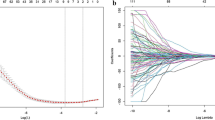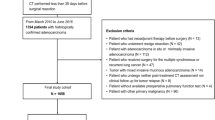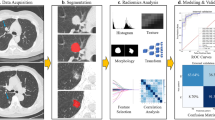Abstract
Objectives
To investigate if delta-radiomics features have the potential to predict the major pathological response (MPR) to neoadjuvant chemoimmunotherapy in non-small cell lung cancer (NSCLC) patients.
Methods
Two hundred six stage IIA-IIIB NSCLC patients from three institutions (Database1 = 164; Database2 = 21; Database3 = 21) who received neoadjuvant chemoimmunotherapy and surgery were included. Patients in Database1 were randomly assigned to the training dataset and test dataset, with a ratio of 0.7:0.3. Patients in Database2 and Database3 were used as two independent external validation datasets. Contrast-enhanced CT scans were obtained at baseline and before surgery. The delta-radiomics features were defined as the relative net change of radiomics features between baseline and preoperative. The delta-radiomics model and pre-treatment radiomics model were established. The performance of Immune-Related Response Evaluation Criteria in Solid Tumors (iRECIST) for predicting MPR was also evaluated.
Results
Half of the patients (106/206, 51.5%) showed MPR after neoadjuvant chemoimmunotherapy. For predicting MPR, the delta-radiomics model achieved a satisfying area under the curves (AUCs) values of 0.768, 0.732, 0.833, and 0.716 in the training, test, and two external validation databases, respectively, which showed a superior predictive performance than the pre-treatment radiomics model (0.644, 0.616, 0.475, and 0.608). Compared with iRECIST criteria (0.624, 0.572, 0.650, and 0.466), a mixed model that combines delta-radiomics features and iRECIST had higher AUC values for MPR prediction of 0.777, 0.761, 0.850, and 0.670 in four sets.
Conclusion
The delta-radiomics model demonstrated superior diagnostic performance compared to pre-treatment radiomics model and iRECIST criteria in predicting MPR preoperatively in neoadjuvant chemoimmunotherapy for stage II-III NSCLC.
Clinical relevance statement
Delta-radiomics features based on the relative net change of radiomics features between baseline and preoperative CT scans serve a vital support tool in accurately identifying responses to neoadjuvant chemoimmunotherapy, which can help physicians make more appropriate treatment decisions.
Key Points
• The performances of pre-treatment radiomics model and iRECIST model in predicting major pathological response of neoadjuvant chemoimmunotherapy were unsatisfactory.
• The delta-radiomics features based on relative net change of radiomics features between baseline and preoperative CT scans may be used as a noninvasive biomarker for predicting major pathological response of neoadjuvant chemoimmunotherapy.
• Combining delta-radiomics features and iRECIST can further improve the predictive performance of responses to neoadjuvant chemoimmunotherapy.






Similar content being viewed by others
Abbreviations
- AUC:
-
Area under the curve
- CR:
-
Complete response
- CT:
-
Computed tomography
- IASLC:
-
International Association for the Study of Lung Cancer
- ICC:
-
Intraclass correlation coefficient
- ICIs:
-
Immune checkpoint inhibitors
- irAEs:
-
Immune-related adverse events
- iRECIST:
-
Immune-Related Response Evaluation Criteria in Solid Tumors
- LASSO:
-
Least absolute shrinkage and selection operator
- LR:
-
Logistic regression
- LUAD:
-
Lung adenocarcinoma
- MPR:
-
Major pathologic response
- NSCLC:
-
Non-small cell lung carcinoma
- PD:
-
Progressive disease
- PR:
-
Partial response
- ROC:
-
Receiver operating characteristic
- ROIs:
-
Regions of interest
- SD:
-
Stable disease
- TNM:
-
Tumor node metastasis
References
Shu CA, Gainor JF, Awad MM et al (2020) Neoadjuvant atezolizumab and chemotherapy in patients with resectable non-small-cell lung cancer: an open-label, multicentre, single-arm, phase 2 trial. Lancet Oncol 21:786–795
Wu J, Hou L, Haoran E et al (2022) Real-world clinical outcomes of neoadjuvant immunotherapy combined with chemotherapy in resectable non-small cell lung cancer. Lung Cancer 165:115–123
Chen Y, Yan B, Xu F et al (2021) Neoadjuvant chemoimmunotherapy in resectable stage IIIA/IIIB non-small cell lung cancer. Transl Lung Cancer Res 10:2193–2204
Chen T, Ning J, Campisi A et al (2022) Neoadjuvant PD-1 inhibitors and chemotherapy for locally advanced NSCLC: a retrospective study. Ann Thorac Surg 113:993–999
Hellmann MD, Chaft JE, William WN Jr et al (2014) Pathological response after neoadjuvant chemotherapy in resectable non-small-cell lung cancers: proposal for the use of major pathological response as a surrogate endpoint. Lancet Oncol 15:e42-50
Esfahani K, Elkrief A, Calabrese C et al (2020) Moving towards personalized treatments of immune-related adverse events. Nat Rev Clin Oncol 17:504–515
Zhao H, Ning J, Gu Y et al (2021) Consecutive severe immune-related adverse events after PD-1 inhibitor induction and surgery in locally advanced non-small cell lung cancer: a case report. Transl Lung Cancer Res 10:3682–3688
Mulkey F, Theoret MR, Keegan P, Pazdur R, Sridhara R (2020) Comparison of iRECIST versus RECIST V.1.1 in patients treated with an anti-PD-1 or PD-L1 antibody: pooled FDA analysis. J Immunother Cancer 8:e000146
Seymour L, Bogaerts J, Perrone A et al (2017) iRECIST: guidelines for response criteria for use in trials testing immunotherapeutics. Lancet Oncol 18:e143–e152
Win T, Miles KA, Janes SM et al (2013) Tumor heterogeneity and permeability as measured on the CT component of PET/CT predict survival in patients with non-small cell lung cancer. Clin Cancer Res 19:3591–3599
Khorrami M, Prasanna P, Gupta A et al (2020) Changes in CT radiomic features associated with lymphocyte distribution predict overall survival and response to immunotherapy in non-small cell lung cancer. Cancer Immunol Res 8:108–119
William WN Jr, Pataer A, Kalhor N et al (2013) Computed tomography RECIST assessment of histopathologic response and prediction of survival in patients with resectable non-small-cell lung cancer after neoadjuvant chemotherapy. J Thorac Oncol 8:222–228
Gillies RJ, Kinahan PE, Hricak H (2016) Radiomics: images are more than pictures, they are data. Radiology 278:563–577
Fave X, Zhang L, Yang J et al (2017) Delta-radiomics features for the prediction of patient outcomes in non-small cell lung cancer. Sci Rep 7:588
Tankyevych O, Trousset F, Latappy C et al (2022) Development of radiomic-based model to predict clinical outcomes in non-small cell lung cancer patients treated with immunotherapy. Cancers (Basel) 14:5931
Goldstraw P, Chansky K, Crowley J et al (2016) The IASLC lung cancer staging project: proposals for revision of the TNM stage groupings in the forthcoming (Eighth) edition of the TNM classification for lung cancer. J Thorac Oncol 11:39–51
Travis WD, Dacic S, Wistuba I et al (2020) IASLC multidisciplinary recommendations for pathologic assessment of lung cancer resection specimens after neoadjuvant therapy. J Thorac Oncol 15:709–740
van Griethuysen JJM, Fedorov A, Parmar C et al (2017) Computational radiomics system to decode the radiographic phenotype. Cancer Res 77:e104–e107
Trebeschi S, Kurilova I, Călin AM et al (2017) Radiomic biomarkers for the prediction of immunotherapy outcome in patients with metastatic non-small cell lung cancer. J Clin Oncol 35:e14520–e14520
Grove O, Berglund AE, Schabath MB et al (2015) Quantitative computed tomographic descriptors associate tumor shape complexity and intratumor heterogeneity with prognosis in lung adenocarcinoma. PLoS One 10:e0118261
Grossmann P, Stringfield O, El-Hachem N et al (2017) Defining the biological basis of radiomic phenotypes in lung cancer. Elife 6:e23421
Gerlinger M, Rowan AJ, Horswell S et al (2012) Intratumor heterogeneity and branched evolution revealed by multiregion sequencing. N Engl J Med 366:883–892
Zhang J, Wu Z, Zhao J et al (2021) Intrahepatic cholangiocarcinoma: MRI texture signature as predictive biomarkers of immunophenotyping and survival. Eur Radiol 31:3661–3672
Raskov H, Orhan A, Christensen JP, Gögenur I (2021) Cytotoxic CD8(+) T cells in cancer and cancer immunotherapy. Br J Cancer 124:359–367
Nasief H, Zheng C, Schott D et al (2019) A machine learning based delta-radiomics process for early prediction of treatment response of pancreatic cancer. NPJ Precis Oncol 3:25
Fave X, Zhang L, Yang J et al (2016) Delta-radiomics: the prognostic value of therapy-induced changes in radiomics features for stage III non-small cell lung cancer patients. Med Phys 43:3750–3750
Jeon SH, Song C, Chie EK et al (2019) Delta-radiomics signature predicts treatment outcomes after preoperative chemoradiotherapy and surgery in rectal cancer. Radiat Oncol 14:43
Beaumont H, Iannessi A, Cucchi JM, Bertrand AS, Lucidarme O (2022) Intra-scan inter-tissue variability can help harmonize radiomics features in CT. Eur Radiol 32:783–792
Mali SA, Ibrahim A, Woodruff HC et al (2021) Making radiomics more reproducible across scanner and imaging protocol variations: a review of harmonization methods. J Pers Med 11:842
Acknowledgements
We would like to thank all colleagues for helping us during the current study.
We thank the patients and their families, and the participating study teams for making this study possible.
HSS, JF, and YDL did the conception and design of the study and the acquisition of data. XYH, YW, CYD, JL, XJ, KLZ, YML, JL, RY, ZC, and JG did analysis and interpretation of the data. XYH and MLW draft the article. All authors did final approval of the version to be submitted.
Funding
This study was supported by the National Natural Science Foundation of China (grant numbers: 82071921).
Author information
Authors and Affiliations
Corresponding authors
Ethics declarations
Guarantor
The scientific guarantor of this publication is Heshui Shi.
Conflict of interest
Chengyu Ding is an employee of ShuKun (BeiJing) Technology Co., Ltd.. The rest of the authors of this manuscript declare no relationships with any companies, whose products or services may be related to the subject matter of the article.
Statistics and biometry
No complex statistical methods were necessary for this paper.
Informed consent
Written informed consent was waived by the institutional review board.
Ethical approval
This retrospective study was approved by the Ethics Committee of Wuhan Union Hospital (0648–01).
Study subjects or cohorts overlap
No study subjects or cohorts have been previously reported in other places.
Methodology
• Retrospective
• Diagnostic or prognostic study
• Multicentre study
Additional information
Publisher's Note
Springer Nature remains neutral with regard to jurisdictional claims in published maps and institutional affiliations.
Supplementary Information
Below is the link to the electronic supplementary material.
Rights and permissions
Springer Nature or its licensor (e.g. a society or other partner) holds exclusive rights to this article under a publishing agreement with the author(s) or other rightsholder(s); author self-archiving of the accepted manuscript version of this article is solely governed by the terms of such publishing agreement and applicable law.
About this article
Cite this article
Han, X., Wang, M., Zheng, Y. et al. Delta-radiomics features for predicting the major pathological response to neoadjuvant chemoimmunotherapy in non-small cell lung cancer. Eur Radiol 34, 2716–2726 (2024). https://doi.org/10.1007/s00330-023-10241-x
Received:
Revised:
Accepted:
Published:
Issue Date:
DOI: https://doi.org/10.1007/s00330-023-10241-x




